KNOWLEDGE CENTER

When it comes to selecting the best roofing solution for your Central Illinois'four-season climate, there are many factors to consider. From the type of material to the style of the roof, each option has its own advantages and disadvantages. Choosing the wrong roofing option can lead to costly repairs and even a total replacement, so proper research is critical. To help you make the best decision for your home or building, we have put together the ultimate guide to choosing the best roofing option for your four-season climate. Let’s dive in and explore your options! The Importance of Choosing the Right Roofing Option Choosing the right roofing option for your four-season climate is crucial. Your roofing system is the only protection your home or building has against the elements. The wrong choice can lead to costly repairs and energy bills. You need to consider the following factors when selecting a roofing option: Climate - Your roofing choice should be able to withstand the weather conditions in your area, ranging from heavy snowfall to high winds and heat. Energy Efficiency - Energy-efficient roofing materials can help reduce your energy costs and make your home or building more environmentally friendly. Durability - Your roofing system should be strong enough to withstand years of exposure to the elements without requiring expensive repairs or replacements. Style and Aesthetics - Your roofing choice should complement the architecture and style of your home or building. Budget - The cost of your roofing system and its installation should be within your budget. By considering these five factors, you can ensure that you make the right choice for your roof, keeping your property safe and secure for years to come. Understanding Climate and Its Effect on A Roof One of the most important aspects of choosing the right roofing option for your four-season climate is understanding the impact that the climate will have on your roof. Different climates can have vastly different effects on your roof, which is why it's important to choose a roofing material that can withstand the unique challenges specific to your area. For example, if you live in a climate with heavy snowfall, you'll want to choose a roofing material that can withstand the weight of snow and ice without collapsing. On the other hand, if you live in an area that experiences high winds or hail, you'll want a roofing material that is durable and can withstand impact without sustaining significant damage. In addition to the weather conditions themselves, it's important to consider the effect that your climate will have on the energy efficiency of your home or building. For example, if you live in a hot climate, you'll want to choose a roofing material that can reflect heat and reduce your cooling costs during the summer months. By understanding your climate and its impact on your roof, you can make an informed decision when it comes to choosing the best roofing option for your property. Whether you're looking for a durable material that can withstand extreme weather conditions or an energy-efficient option that can save you money on your utility bills, understanding your climate is crucial to making the right choice. Types of Roofing Materials for Four-Season Climates When choosing the best roofing option for your four-season climate, it's important to consider the different types of roofing materials available. Here are four types of roofing materials that are ideal for different climates: Asphalt Shingles – These are popular roofing materials for all types of climates due to their versatility and durability. They are affordable and come in a variety of colors, which makes them a good fit for any four-season climate. Asphalt shingles work well in hot and cold climates. Metal Roofing – Metal roofing materials are ideal for areas with high winds, hail, and heavy rains. They are durable and resistant to damage, making them a good option for harsh weather conditions. Metal roofing is also energy efficient, which makes them ideal for hot climates. Tile Roofing – Tile roofing is best suited for hot climates due to its ability to reflect heat, keeping your home cool during hot summer months. They are also resistant to damage from strong winds and rain. However, they can be heavy, so not all homes can support the weight. Slate Roofing – If you live in a cold climate, slate roofing materials are a good option because they are strong, durable, and can withstand heavy snow and ice. They are also fire-resistant, making them a good option for areas prone to wildfires. By understanding the different types of roofing materials available and their suitability for specific climates, you can make an informed decision when choosing the best roofing option for your property. Consider the unique challenges of your climate and the desired energy efficiency when choosing the right material. Pros and Cons of Common Roofing Options When it comes to choosing a roofing option for your four-season climate, there are plenty of commonly used roofing materials to consider. Each material has its own set of pros and cons, so it's important to compare them before making a decision. Here are a few of the most popular roofing options and their respective pros and cons: Asphalt shingles - As one of the most common roofing materials, asphalt shingles offer affordability, durability, and easy installation. However, they may not be as weather-resistant as some other materials, and they may not be as aesthetically pleasing. Metal roofing - Metal roofing can withstand harsh weather conditions and is much more durable than asphalt shingles. They are also eco-friendly and energy-efficient. However, they can be more expensive and may require professional installation. Slate roofing - Slate is a premium roofing material that is incredibly durable and weather-resistant. It also adds a unique aesthetic appeal to homes. However, it can be very costly and difficult to install. Tile roofing - Tile roofing is another premium option that offers durability and aesthetic appeal. It is often used in Mediterranean-style homes. However, it can be heavy, making it difficult to install, and expensive to repair. Wood shingles or shakes - Wood shingles or shakes offer a natural and rustic appeal to homes. They are also environmentally friendly and can last a long time with proper maintenance. However, they can be more susceptible to fires and rot, and may not be as durable as other options. Rubber roofing - Rubber roofing is a more affordable option that is durable and energy-efficient. It is often used on flat roofs and requires low maintenance. However, it may not be as aesthetically pleasing and can be prone to puncture damage. By comparing the pros and cons of these popular roofing materials, you can choose the one that best fits your needs and budget. Consider hiring a professional roofing contractor to help you make an informed decision and ensure proper installation. Peoria Il Roof Installation and Maintenance When choosing the best roofing option for your four-season climate, it is important to consider not only the pros and cons of the different materials, but also installation and maintenance considerations. Installation - Make sure to hire a professional roofing contractor to ensure proper installation of your chosen roofing material. The cost of installation can vary based on the material chosen and the size of your roof. Some materials may require more time and labor to install than others. Maintenance - Regular maintenance is important to ensure the longevity and effectiveness of your roofing system. Consider the cost and level of maintenance required for each roofing material. Some may require more frequent inspections and repairs than others. For example, metal roofing may require occasional coating or sealing to prevent rusting. Climate Compatibility - Choose a roofing material that is compatible with your climate. Consider factors like wind, rain, snow, and temperature fluctuations. Some materials may be better suited for colder, wetter climates, while others may perform better in hotter, drier climates. Your roofing contractor can provide recommendations based on your specific climate. Warranty and Lifespan - Be sure to consider the warranty and expected lifespan of your chosen roofing material. Some materials may come with a longer warranty or higher expected lifespan than others, making them a better long-term investment. By taking these installation and maintenance considerations into account, you can ensure that the roofing option you choose for your four-season climate will provide the best durability, performance, and value for your home or building. Making the Final Decision After considering all the factors mentioned above, it's time to make the final decision on the best roofing option for your four-season climate. Here are some key points to keep in mind when making your decision: Budget – Consider the cost of the roofing material, installation, and maintenance when making your decision. Durability – Look for a roofing option that will last for a long time and can withstand the climate in your area. Energy efficiency – Some roofing materials are more energy-efficient than others, which can save you money on heating and cooling costs. Appearance – Choose a roofing material that fits with the style of your home or building and enhances its overall appearance. Environmental impact – Consider the environmental impact of your chosen roofing material, including its carbon footprint and recyclability. Local regulations – Check with your local government or building codes to ensure that your chosen roofing material is in compliance with any regulations or restrictions. By considering all of these factors, you can make an informed decision on the best roofing option for your four-season climate. Remember, your roof is an investment in your home or building, so it's important to choose wisely. Choosing the right roofing option for your four-season climate is a crucial decision that requires careful consideration. By evaluating factors such as budget, durability, energy efficiency, appearance, environmental impact, and local regulations, you can make an informed decision that meets your needs and preferences. It's also important to invest in proper installation and regular maintenance to ensure that your roof performs optimally over the long term. Whether you choose asphalt shingles, metal roofing, or another material, a well-constructed and well-maintained roof can protect your home or building from the elements and enhance its value and aesthetic appeal. So, take your time, do your research, and consult with roofing professionals to make the best decision for your unique situation. With the right roofing option, you can enjoy a comfortable, efficient, and visually pleasing space year-round.

What To Know About Insulation and Roof Installation Insulation plays a significant role in professional roof installations that shouldn’t be undervalued. Insulation offers many advantages that affect energy efficiency, comfort, and overall roof performance in addition to simply keeping your home warm in the winter and cool in the summer.

Your home’s roof is its first line of defense against harsh weather conditions and other external elements. It provides you and your loved ones with security and protection. However, like any other part of your home, your roof eventually becomes worn and requires replacement. Knowing the signs of when it’s time to replace your roof can save you money, stress, and a lot of damage to your home. If you’re a homeowner in Central Illinois, this essential guide is for you. Keep reading to learn everything you need to know about when it’s time to replace your roof. Signs A Roof Needs Replacing As a homeowner in Central Illinois , it’s important to know the signs that your roof needs to be replaced. Here are a few things to look out for to have excellent roofing : Age – A typical asphalt shingle roof lasts around 20-25 years. If your roof is approaching that age range, it’s time to start thinking about a replacement. Buckling or Curling Shingles – If you notice shingles that are buckling, curling, or losing granules, it’s a sign that your roof is deteriorating and needs to be replaced. Leaks – A leak inside your home is a clear sign that your roof needs attention. It’s important to address the issue immediately to prevent any further water damage. Daylight Through the Roof Boards – If you can see daylight coming through your roof boards, it’s time for a replacement. This is a serious issue and needs to be fixed right away to prevent further damage. Sagging – A sagging roof is a sign of a serious problem. It could be due to a structural issue or weakened foundation. If you notice any sagging, call a professional immediately. High Energy Bills – If your energy bills have been increasing, it could be a sign that your roof isn’t functioning properly. Poor ventilation or insulation can cause your HVAC system to work harder, resulting in higher energy costs. If you notice any of these signs, it’s important to call a professional roofer like Peoria IL Roofing Company to assess the situation. Ignoring these warning signs can result in more expensive repairs down the road or even a complete roof collapse. Don’t wait until it’s too late – keep your home and loved ones safe by replacing your roof when necessary, and trust roofing experts and their advice. Age of your roof True roofers will tell you aging is a significant factor when determining if it's time to replace your roof in Central Illinois. Most asphalt shingle roofs have a lifespan of around 20-25 years. If your roof is approaching this age range, it's time to start planning for a replacement. It's important to note that the age of your roof isn't always the lone determining factor. A roof that's been properly maintained and cared for can last longer than its expected lifespan. On the other hand, a roof that's been subjected to harsh weather conditions or neglect may need to be replaced earlier than anticipated. To determine the age of your roof, review the installation date or records if they are available. If those records are not readily available, a professional roofer can help you assess your roof's age and condition. They can also provide guidance on if it's time to replace your roof or not. Ignoring the age of your roof can lead to expensive repairs, leaks, and even collapses. It's always better to be proactive and replace your roof at the appropriate time rather than waiting for costly and potentially dangerous problems to arise. Don't take chances with the safety of your home and your loved ones – get your roof assessed by a professional if it's reaching its expected lifespan. Look for leaks While age is a significant factor in determining whether it's time for a roof replacement in Central Illinois, there are other signs to look out for. One of the most crucial signs is the presence of leaks. Leaks can be caused by a multitude of factors, such as old or damaged shingles, improper installation, or a lack of maintenance. It's essential to inspect your roof regularly for leaks. Typically, leaks will present themselves as stains or damp spots on your ceiling or walls. You may also notice mold or mildew growth, a musty odor, or bubbling paint. If you suspect a leak, it's vital to take action right away to prevent further damage. Another sign to look out for is missing or damaged shingles. If you notice shingles that are cracked, curled, or missing, it's time to call a professional roofer. Damaged shingles can compromise the integrity of your roof, and if left unaddressed, can lead to leaks and other issues. Lastly, keep an eye out for any sagging or uneven areas on your roof. These are typically signs of structural issues and may indicate that a replacement is necessary. In summary, while age is an important factor in determining the need for a roof replacement in Central Illinois, it's not the only one. Keep an eye out for leaks, damaged shingles, and structural issues to ensure that your roof remains in excellent condition and provides reliable protection for your home. Shingle Damage Damaged shingles are a common sign that it may be time to replace your roof in Central Illinois. Shingles can be damaged by severe weather, such as hail or strong winds, or wear and tear over time. Here are five types of shingle damage to look out for: Cracking – If your shingles are cracked, they are no longer providing adequate protection to your roof. Cracks can allow water and debris to seep into your roof, leading to leaks and other issues. Curling – Shingles that are curling up at the edges are a sign of age and wear. As shingles curl, they become more susceptible to damage and can easily be torn off by strong winds. Blistering – Blistering occurs when the shingle's upper layer starts to separate from the lower layer, causing bubbles or blisters to form. This can be caused by poor ventilation, excessive heat, or improper installation. Missing Granules – Granules on shingles protect them from UV rays and provide a barrier against moisture. Loss of granules can make shingles more vulnerable to damage and deterioration. Missing or Loose Shingles – Missing or loose shingles can lead to leaks and other issues. It's essential to replace missing or loose shingles as soon as possible to prevent further damage to your roof. Regular inspections of your roof can help you identify shingle damage and other issues before they become major problems. If you notice any of these types of shingle damage, it may be time to call a professional roofer to assess the damage and recommend a course of action. Other Structural Damage Apart from shingle damage, there are other signs of structural damage that indicate it may be time to replace your roof in Central Illinois. Here are six other types of structural damage to look out for: Sagging – A sagging roof is a serious structural issue caused by excessive weight, such as snow or water buildup. It can lead to roof collapse if left unchecked. Rotting – Rotting can occur when moisture penetrates the roofing material, causing it to break down and decay. This can lead to weakened support beams and structural damage. Leaks – Leaks can occur when the roofing material becomes damaged or deteriorated, allowing water to seep into the roof. Crumbling Chimneys – A crumbling chimney can be a sign of water damage and structural issues with the roof. Mold or Mildew – Mold and mildew growth can cause damage to the roof decking and other structural components if left untreated. Aging – Even if there is no visible damage to your roof, it may be time to replace it if it is over 20-25 years old. As a roof ages, it becomes less effective at protecting your home from the elements. It's important to address any structural damage as soon as possible to prevent further damage to your roof and home. A professional roofer can assess the damage and recommend the best course of action for your specific situation. Finding the Right Contractor for Roof Replacement Once you've determined that it's time to replace your roof, the next step is finding the right contractor for the job. Here are some tips for finding the right contractor in Central Illinois: Look for Experience – Choose a contractor with years of experience in the roofing industry. An experienced contractor will have the knowledge and expertise necessary to handle your roof replacement efficiently and effectively. Check Reviews – Look for contractors with positive reviews from satisfied customers. Check online review sites such as Angie's List and the Better Business Bureau to get an idea of the contractor's reputation. Ensure License and Insurance – Make sure the contractor has a valid license and insurance. This protects you from liability in case of any accidents or damages during the project. Get Multiple Quotes – Get quotes from several contractors to compare prices and services offered. Don't choose the cheapest option, as this may result in low-quality work and materials. Ask for References – Ask contractors for references from previous customers. Contact these customers and ask about their experience with the contractor. Check for Warranty – Look for a contractor that offers a warranty on their workmanship and the materials used. This ensures that any issues with the roof will be fixed at no additional cost to you. By following these tips, you'll be able to find the right contractor for your roof replacement project in Central Illinois. Remember to take your time in choosing a contractor and don't rush into making a decision. A quality roof replacement can protect your home for years to come, so it's important to get it done right. Selecting the Best Materials for Roof Replacement Choosing the right materials for your roof replacement in Central Illinois is vital to the longevity and durability of your new roof. Here are some things to consider when selecting materials: Climate – Central Illinois experiences extreme temperature fluctuations, from hot summers to cold winters. Choose materials that can withstand all types of weather and temperature changes. Durability – Consider the lifespan of the materials. Certain materials, like asphalt shingles, may need to be replaced more frequently than others, like metal roofing. Cost – While cost is an important factor, don't skimp on quality materials just to save money in the short-term. Investing in high-quality, durable materials can save you money in the long-term by reducing the need for frequent repairs and replacements. Energy Efficiency – Consider the energy efficiency of the materials. Some materials, like metal roofing, can reflect the sun's heat and reduce energy consumption in the summer months. Aesthetics – The appearance of your roof is also important. Choose materials that complement the style and architecture of your home. Maintenance – Consider the maintenance required for the materials. Certain materials may require more frequent maintenance and cleaning than others. By considering these factors and working with a reputable contractor who can provide recommendations on the best materials for your specific needs, you can ensure a high-quality and long-lasting roof replacement for your home in Central Illinois. Roof Cost vs. Value When it comes to replacing your roof, cost versus value is an important factor to consider. While it may be tempting to go for the cheapest option, it's important to look at the long-term value of your investment. Here are some things to keep in mind when weighing cost versus value: Quality of Materials - Investing in high-quality materials, even if they cost more upfront, can save you money in the long run by reducing the need for frequent repairs and replacements. Energy Efficiency - Energy-efficient materials, such as metal roofing or reflective coatings, can help reduce your energy bills and save you money over time. Contractor Experience - Choosing a reputable contractor with experience and expertise in roof replacements can ensure that the job is done correctly and to a high standard, reducing the need for costly repairs down the line. Warranty - Look for roofing materials and contractors that offer a warranty for their work. This can provide peace of mind and save you money in case any issues arise in the future. Resale Value - A new roof can increase the resale value of your home, making it a worthwhile investment in the long run. By keeping these factors in mind, you can make an informed decision about the cost versus value of your roof replacement and ensure that you are investing in a high-quality and long-lasting solution for your home in Central Illinois. Maintaining and Improving Your Roof in Central Illinois While roof replacements are necessary at times, proper maintenance and improvements can extend the life of your roof and save you money in the long run. Here are some tips for maintaining and improving your roof in Central Illinois: Regular Inspection and Cleaning - Regular roof inspections and cleanings can help identify and prevent potential issues, such as leaks or damage from debris or weather. Clean gutters and downspouts regularly to avoid water damage. Repairing Damage Promptly - Addressing any damage or issues with your roof promptly can prevent further damage and expenses. Make repairs as soon as possible to avoid them becoming more significant issues. Ventilation Improvements - Proper ventilation can improve the lifespan of your roof by preventing moisture buildup and heat damage. Consider adding attic fans or vents to improve air circulation. Insulation Improvements - Proper insulation can also help improve ventilation and energy efficiency, reducing energy bills and preventing potential damage from ice dams. Upgrades - Consider upgrading to high-quality materials, such as impact-resistant shingles or energy-efficient coatings, to improve the lifespan and value of your roof. By implementing these maintenance and improvement tips, you can extend the life of your roof and avoid costly replacements. Don't neglect the importance of taking care of your roofing system, as it plays a critical role in protecting your home and family. Knowing when it's time to replace your roof in Central Illinois is crucial for the safety and well-being of your home and family. While proper maintenance and improvements can help extend the life of your roof, there will come a time when replacement is necessary. Regular inspections, prompt repairs, and upgrades can all contribute to the longevity and value of your roofing system. Don't wait until it's too late; take action to ensure the protection of your home and loved ones. When you look for roofing companies Peoria Il , look no farther than Peoria Il Roofing Company . Give us a call for a free estimate. 309-322-9148


